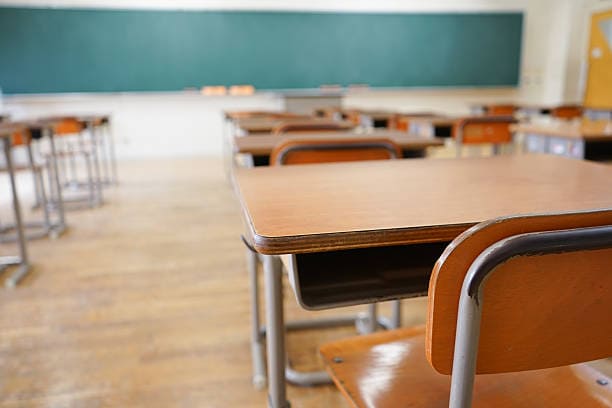The Most Important Lessons Teachers Impart Are Not
The Most Important Lessons Teachers Impart Are Not ‘Dictated by a Pacing
Guide’
Neema Avashia is the daughter of Indian immigrants and was born and raised in
the hills of southern West Virginia. She has been an educator in the Boston
public schools since 2003, primarily as a civics and history teacher, and was
a Boston educator of the year in 2013. This fall, she moves out of the
classroom and into a coaching role, supporting ethnic-studies teachers across
the same district:
This past June, instead of packing up my classroom, I dismantled it.
Encouraged colleagues to come and take what they wanted, recycled, donated,
and trashed whatever was left. This is the end of my 19th year teaching. For
now, at least, it’s also the end of my time as a teacher. I have not returned
to the classroom this fall.
If I’m honest, this moment has been coming for a while now. About five years
ago, I began to battle with my school system in a way that I’d never had to
previously. Sure, I’d pushed back against poor-quality assessments and
microaggressive report card comments. I’d advocated hard for a nurse in every
school and for changes that would make the transition to high school smoother
for rising 9th graders. But I’d never felt the full force of a school system
coming down on me the way it started to in the fall of 2017, when the Boston
district announced that they were closing my school, scattering the staff and
students, only to then renovate the school and give it over to another
community to inhabit. In effect, we were being gentrified out of our school
building.
The fight to stop that closure (which we won), followed by a subsequent fight
to hold onto our students’ only access to green space for play (which we
lost), followed by an initial COVID response plan that provided $19 box fans
as the only source of ventilation while asking us to simultaneously teach
online and in person, ultimately became too much. I felt as though my school
district had become a giant fortress of ill logic, with thick brick walls, and
my job was just to keep hurling myself into the wall in the hopes that I might
break through and get us to solutions that made better sense, that took care
of people instead of rendering harm down on them.
But eventually, the wall became too big. Too impenetrable. I wasn’t breaking
through; I was breaking. I was less patient. Quicker to frustrate. Less able
to bounce back from challenges at work and at home. My body has made it clear
that it needs respite. Needs time to recover from repetitive impact. That the
only thing I am equipped to do right now is to extend care: first to myself
and then to my colleagues in this work.
Looking back on my career, I am struck by how much unlearning I have needed to
do to get to this point. How much of what was initially communicated to me
about education, about its goals, about how it is best done, was in fact
entirely wrong. And how so many of these ideas continue to hold credence
nearly two decades later, when in fact we should discard them and build anew.
1. Compliance is not the goal. I began teaching in 2003, right around the time
when policies inspired by No Child Left Behind started to come down hard on
students in classrooms all over the country. High-stakes testing,
broken-windows policing, and “no excuses” strategies applied in classrooms in
an effort to compete with charter schools that kicked out any students who
“weren’t a good fit” for their learning environment. Use of
standardized-testing data to measure teacher effectiveness. To shutter schools
deemed “underperforming.” The result of this wave of punitive, fear-mongering
policy was an obsessive focus on compliance in schools. If kids weren’t
complying, then there was something wrong with them. They needed to be fixed.
If they couldn’t be fixed, they needed to leave.
I grew up in rural, majority-white schools and became a teacher in city
schools populated almost entirely by students of color. When I started this
work, I didn’t possess the systems analysis that I needed to do this work
well. Instead of listening hard to the part of me that wanted to center young
people’s humanity, I aspired to the definition of “effective teaching” that
the system articulated: one that prioritized urgency, prioritized results,
prioritized compliance above all else. It took me far too long to unlearn
ideas about schooling rooted in institutional racism. To reject the messaging
passed down from administrators and leaders and society at large that our
focus should be on getting students to comply with the increasingly oppressive
rules and narrow curriculum that we were offering.
In truth, those students who were not complying were my best teachers. They
were telling me, through their words, and their bodies, and their choices,
exactly what didn’t work about school and why it didn’t work. They were
pointing us all toward more liberatory models of education—ones that center
relationships, agency, and relevance. But it took me too long to listen to
them, to lift up what they were seeing, to imagine different ways for moving
forward. And in the process, I lost too many of those students. We lose too
many of those students. To push out. To overdoses and violence and
incarceration. If I could go back, I would have started listening to those
young people from the very beginning and building my classroom around what
they said they wanted and needed.
2. Standardization is not the way to meaningful engagement. During my first
year as a teacher, the director of curriculum and instruction for the city
came to observe my classroom for a “curriculum-implementation review.” The
goal was to see how effectively my teaching was aligned to the city’s pacing
guide. Was I teaching the standards they said I needed to be teaching, during
the week when they said to be teaching them, on the day when they believed
they needed to be taught? The director wrote pages of praise for me after his
observation, about how faithfully I was soldiering through what had been laid
out. Looking back, I can only think about how both he, and I, were so wrong
about that goal.
Because the most impactful lessons that students have taken away from my
classroom have not been the ones that are dictated by a pacing guide. They are
the ones that are responsive to context. They’ve happened in the moments when
I’ve looked at what I’m “supposed to” be teaching and said, “Wait a minute.
This isn’t right.” Or, “This is leaving key information out,” or, “I think
kids need to feel this and not just read it,” and then worked to fill in the
gaps.
The most powerful moment in learning the history of school desegregation for
my students didn’t come from any book or video. It came from listening to
Terrence Roberts speak with them about his experiences integrating Central
High School. To understand the inhumanity of solitary confinement, my students
read first-person testimonials, analyzed statistics, and crafted a response to
a document-based question. But the reality of that experience didn’t hit home
for students until I built a cube of 6×9 dimensions out of PVC pipe and placed
it in my classroom so they would feel the intensity of being held within those
walls for a few minutes, never mind 23 hours a day. To reflect on the long
history of institutional racism in this country, and its continued impact, I
gave students cardboard and glue and spray paint and watched with awe as they
built incredible scale-model memorials that could be constructed to force
Americans to confront and grapple with our hard history. When learning about
hegemony, and how we resist it on the individual level, I brought in BIPOC
friends and former students to talk through their experiences with navigating,
and working in, dominant spaces.
Those moments were where the learning became most real. Where theoretical
ideas and texts suddenly became solid, became lived, because we were living
them with other people. I wish I could have created these opportunities
earlier for my students. Created them more often. Understood earlier that it
is through lived experience and human connection where the deepest learning
happens, no matter what a pacing guide is telling you to do.
3. Exceptionalism is not the fix. I grew up as an exception—one of very few
students of color in a majority-white context. A queer kid who didn’t have
language or models to give name to my queerness. I think in a lot of ways this
shaped my outlook on everything. I survived through sheer force of will. And I
approached teaching this same way: as something I could excel at through sheer
force of will.
I was wrong. Will is not sufficient. And closing your door to the big picture
so that you can “just focus on teaching” is also not the solve. The systemic
inequities that are coming down on young people, coming down on all of us,
really, demand our attention and our energy. But battling them is not
something any of us can do alone. It requires us to be in deep and sustained
relationships with young people, with their families, and with people in the
communities where our schools are situated. When I have succeeded in pushing
back on unjust decisions in my school system, it has been because I’ve been
working in concert with others, because we’ve listened hard to one another,
and identified a shared way forward. And when I’ve failed, it’s because the
foundation underneath the fight has been less solid.
The scale at which we are asked to work—the number of students, the number of
preps, the lack of meaningful time during the school day for doing any of the
important work—makes it incredibly difficult to build relationships in the
ways we need to. It requires you to make conscious choices about how you use
your time: In the choice between grading another stack of papers or having a
conversation with a young person or family or colleague, the conversation, the
relationship, needs to be the first choice. I didn’t understand this for too
long. But if there’s nothing else you take from this, then take this
unlearning: the most important work you can do as an educator is to focus on
relationships. To let listening to the needs of the folks most impacted be the
thing that drives every decision that you make.
I wish I could go back and tell my first-year teacher self: This work you are
embarking on is a marathon without end. There is no “done.” There is no finite
marker of success. There is just the choice you make every day to center the
humanity of young people, of families, and of yourself in a context where
humanity is least often the value driving decisionmaking.
Over the past two decades, I have been known to look back on my first year of
teaching with much chagrin. I have been known to say, “If those 4th graders
learned anything, it was in spite of me.” I don’t think it was truly terrible,
but that year certainly paled in comparison with the years that followed.
Knowing that, knowing how difficult the first year can be for almost all of
us, my first piece of advice for my first-year teacher self would be: Keep
Work Samples. Take pictures or save documents or whatever to have examples of
student work and learning. I did some of this my first year, and it was a gift
to be able to look back, both throughout that year and in the years to come,
and see tangible proof of all my students had achieved. It was also handy to
have student examples of some things, poems, artwork, brochures, math
strategies, to share with students in subsequent years. Having student work
samples available to me is a lesson I learned early on, and I remain grateful
for it.
The next thing I would tell my first-year teacher self would be: You Are the
Expert. Even a first-year teacher knows far more than they think they do. It
is easy to be intimidated by families and by colleagues and second guess what
you are doing. Definitely reflect based on feedback you are getting but don’t
question your own knowledge. Over the years, you will refine what you do based
on that knowledge (and your ongoing learning), and in that first year, it can
be hard to be as clear about why you are doing things as you might like to be.
You are not alone in this, but, more importantly, it doesn’t mean you don’t
know what you are doing. You do. Keep your students as your focus, work with
your colleagues, and believe in your own expertise.
Finally, I wish first-year teacher me had been told that I didn’t have to give
homework. That would have been so freeing. Don’t Give Homework. (I say this as
an elementary educator.) In my first several years of teaching, I spent a
ridiculous amount of time and energy on generating homework, collecting
homework, badgering kids about homework, and grading homework. When I realized
how often I desperately wanted to dump the whole pile in the recycling bin, I
began to question my choices. A little research proved to me that I didn’t
have to keep doing this. I knew, anecdotally, that the great majority of my
students didn’t want to be doing homework any more than I wanted to be dealing
with it. I knew, anecdotally, that many of their families would have been
fine, or even ecstatic (those families fighting with their 4th grader over it
every night), if I didn’t assign homework. So discovering that homework has no
effect or a negligible effect on student achievement allowed me to dump it.
I can’t change that first year now and I’ve come to terms with that. Those of
us with years of teaching experience under our belts can let first-year
teachers know that they’re doing great. We can also give them permission to
stop doing things they feel required to do or to, at a minimum, question
things like homework. We can offer them that.





